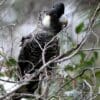Baudin’s Black Cockatoo
Also known as:
Black Cockatoo, White-tailed Black Cockatoo, White-tailed Cockatoo, Long-billed Black Cockatoo, Long-billed White-tailed Black Cockatoo
Also known as:
Black Cockatoo, White-tailed Black Cockatoo, White-tailed Cockatoo, Long-billed Black Cockatoo, Long-billed White-tailed Black Cockatoo
DID YOU KNOW?
There are only a few thousand Baudin’s Black Cockatoos left in the wild.

Zanda

baudinii
Size:
56 cm (21.8 in)
Weight:
630-750 g (22-26.25 oz)
Subspecies including nominate:
one
Colour Adult:
Male-in general grey/black plumage, feathers finely margined with dusty white; ear-coverts dusty white; side tail feathers with broad white band near end. Beak dark grey and narrow with elongated tip. Eye ring pink, eye dark brown. Female-ear-coverts brighter clearer white; beak horn in colour and narrow with elongated tip. Eye ring grey.
Colour Juvenile:
Ear-coverts dull white, sometimes yellowish; narrower tail band with irregular spotting. Beak horn coloured, narrow and elongated, washed with grey. Eye ring grey.
Call:
Contact call while in flight is unusual, high-pitched wailing note; also sometimes while perching. Also described as sad and plaintive. Grating or croaking while feeding and harsh screech in alarm.
More Information:
Avibase
BirdLife Australia: Southwest Black Cockatoo Recovery
Content Sources:
CITES
BirdLife International
Cornell Lab of Ornithology/Birds of the World
A Guide to Parrots of the World, Juniper and Parr, 1998
Parrots: Status Survey and Conservation Plan 2000-2004, Snyder, McGowan, Gilardi and Grajal, 2000.
Parrots of the World, Forshaw and Cooper, 1977, 1989. 2010 edition
Vanished and Vanishing Parrots, Forshaw, 2017.
Parrots of the World, Forshaw, 2006.
Parrots in Aviculture, Low, 1992.
Guide to Incubation and Handraising Parrots, Digney, 1998.
Captive Status:
Uncommon in Australia, very rare outside Australia.
Longevity:
50 or more years.
Housing:
Walk-in enclosure, minimum length 7 m (23 ft).
Diet:
Nuts including: walnuts, almonds and pine nuts; sunflower seed, wheat, maize and fresh corn; green leaves and food and fruit may be accepted. Vegetables such as peas in the pod and, in Australia, banksia and hakia nuts. Complete kibble. Mealworms while rearing young.
Enrichment:
Are avid chewers so provide lots of bird-safe branches and wood blocks (pine, fir, etc), vegetable tanned leather toys.
Nest Box Size:
—
Clutch Size:
1 or 2
Fledging Age:
11 weeks
Hatch Weight:
—
Peak Weight:
—
Weaning Weight:
—
World Population:
2500-4000 mature individuals, rapidly decreasing.
IUCN Red List Status:
Critically Endangered
CITES Listing:
Appendix II
Threat Summary:
The population is inferred to have declined by more than 90% over the past three generations. A quarter of this species’ habitat has been cleared for agriculture, logging and mining. The loss of old-growth trees is causing a severe shortage of nest sites. Is illegally shot by farmers, but an examination of the problem suggests that protective netting of their trees would provide a better result. There is also a threat from non-native bees in nest cavities. Projections of heat, drought, and fire all suggest less forest food and fewer sites with accessible drinking water will be available between now and 2062.
Range:
SW Australia, north to Darling Range, east to longitude 117E.
Habitat:
Found in wet sclerophyll forests during breeding season, favouring Karri. Outside breeding season may range to farmland, orchards and open woodland.
Wild Diet:
Feeds on seeds from the large fruit of marri Eucalyptus calophylla and the seeds of a variety of native plants including Banksia and Dryandra. Also takes insect larvae and visits orchards for fruit and seeds both in trees or dropped on the ground.
Ecology and Behaviour:
Is wary and difficult to approach. Sentinels alert groups of 50 or more birds that congregate to feed. Pair bond is permanent. Flocks in winter seen in parties of three with two adults and an immature.
Clutch and Egg Size:
1 or 2 ovate eggs, 50 x 34.5 mm (2 x 1.3 in)
Breeding Season:
August-January. Nest is in large tree hollow.
Related Links:









![© node worx [CC BY 2.0] via Flickr Wild Baudin's Black cockatoos perch in a shrub](https://parrots.org/wp-content/uploads/2023/01/wpt_Baudins-Black-Cockatoo_1435-8-100x100.jpg)
![© node worx [CC BY 2.0] via Flickr Wild Baudin's Black Cockatoos feed in a shrub](https://parrots.org/wp-content/uploads/2023/01/wpt_Baudins-Black-Cockatoo_1435-7-100x100.jpg)




